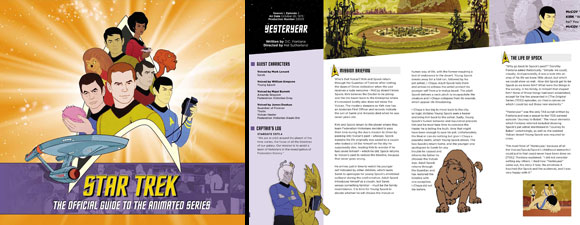Retro Review: Beyond the Farthest Star
4 min readA formless, malevolent entity takes control of the Enterprise, but Kirk lures it into an imploded star mass to save the galaxy.
Plot Summary: The USS Enterprise’s mission to explore the fringe of the galaxy brings the ship within the gravitational pull of the imploded star Questar M-17. Though the ship manages to avoid a collision, it is trapped in orbit. Kirk has Spock researching the possibility of a slingshot when the crew discovers an advanced, lifelike alien pod ship that appears to be hundreds of millions of years old. Kirk, Spock, McCoy, and Scotty put on life-support belts and beam over to investigate, learning that an insectoid race built the ship but lost their lives to an alien attacker. When the away team beams back to the Enterprise, a noncorporeal entity beams over with them, taking over ship’s systems and demanding to be taken to the center of the galaxy so that it can take over other ships and planets. Rather than cooperating, Kirk orders the Enterprise on an apparent collision course with Questar M-17, tricking the alien into leaving the ship just before Spock implements the slingshot around the dead star that takes the Enterprise safely out of orbit. The entity remains trapped within Questar M-17’s gravity, pleading not to be left alone.
Analysis: No matter how many times I watch animated Star Trek reruns, I’m always surprised by the Las Vegas-style theme music and cheesy star animation of the opening. If the original series looks dated on my television set, even the remastered episodes – tinfoil cave walls can only be improved so much – then the animated episodes look like a relic from an even earlier time, though they were produced several years after the original ended. Oddly, though animation allows all sorts of possibilities that would be exorbitantly expensive on live-action television if they worked at all – non-humanoid aliens, water planets, zero-gravity flotation – the artists chose, for example, to create life support belts that act as personal force fields, characterized by a yellow glow around a character wearing one, rather than illustrating environmental suits like the one Kirk wore in “The Tholian Web,” which would logically follow and wouldn’t require any live actors to put on clunky, hot spacesuit costumes. (This looks particularly silly in retrospect since the crews of the later series had to contend with such spacesuits; why would Starfleet ever have gone back?)
I’m not an aficionado of 1970s TV cartoons, but because of choices like that, Star Trek doesn’t seem terribly progressive visually. On the other hand, the animated spin-off has a number of things going for it, not least of which is nearly all the original cast reprising their roles, plus two aliens made possible on the animated show because no makeup is necessary – the three-armed, three-legged Lieutenant Arex, voiced by James Doohan, and the catlike M’Ress, voiced by Majel Barrett, with both actors also playing their more familiar characters, Scotty and Nurse Chapel. It also has the participation of series creator Gene Roddenberry and scripts by D.C. Fontana (“Journey To Babel”), David Gerrold (“The Trouble With Tribbles”), and Larry Niven (Ringworld). And however silly they may look at moments, the characters sound like themselves – same humor, same relationships, same areas of interest. Plus Uhura and Chapel get more to do, which is always a good thing.
“Beyond the Farthest Star,” which was the fourth animated episode filmed yet the first one aired, is neither particularly great nor particularly terrible. The plot’s a bit derivative, but that was true of many original series third season episodes as well, and the science is a bit wobbly – hypergravity? – but considering that this is another episode by the writer who brought us “Where No Man Has Gone Before,” not shockingly so. The dialogue at the beginning all sounds comfortably familiar, with Sulu calculating the speed, Spock explaining the science, Kirk wondering whether they can escape using a technique with which we’re all familiar from earlier Star Trek episodes, and McCoy providing the color commentary (with Spock snarking that he’s not being logical throughout). The decision to board the alien ship seems rash yet typical for Kirk – nothing but a life belt against who knows what! And visually, the ship is interesting to look at, if a bit hard to believe as a working starship.
I’m not at all a fan of the seizure-inducing light visuals as Spock tries to translate the alien language, though it’s fun watching the screen explode. The noncorporeal alien is something of a disappointment since a green swirly blob looks about the same whether it’s live action or animated, and I’m afraid the green slime attack is mostly giggle-inducing, not to mention its turn auditioning for “Wolf in the Fold” when taking over the ship’s computer. Unsurprisingly, my favorite bits are when Kirk agrees to do what the alien wants to protect Spock, then locks out the alien and convinces Spock to do the calculations for a slingshot in his mind so the alien can’t get the information out of the computer. It reminds me of elements of both the fourth and fifth motion pictures, which were many years off when the animated series first aired, and in retrospect, that makes “Beyond the Farthest Star” feel like quite a solid installment.






